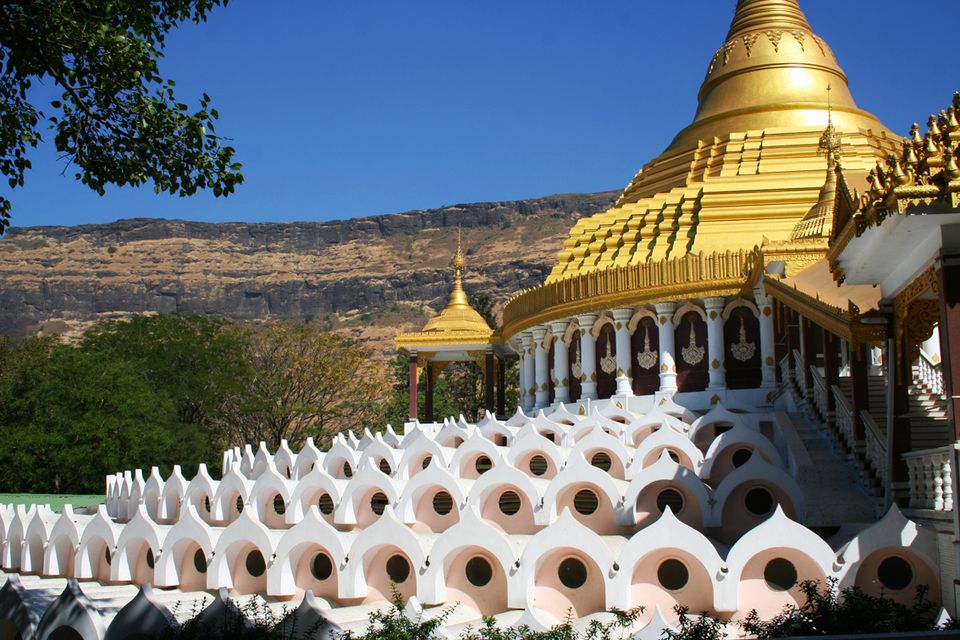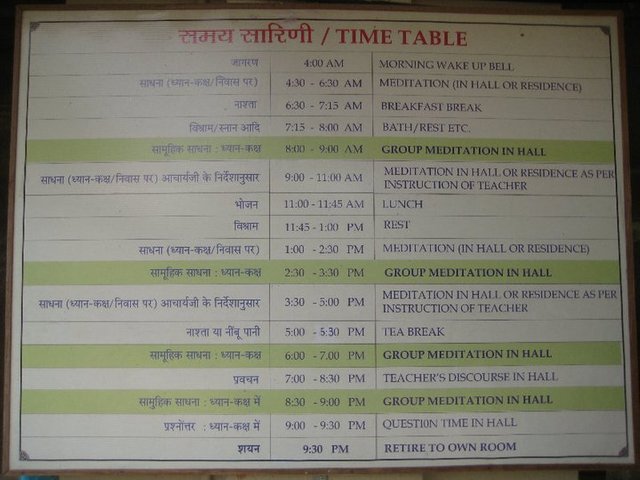My Vipassana Experience: The Road to Dhamma Giri
In September 2017, my husband and I completed a 10-day Vipassana course in rural India. We studied at Dhamma Giri, the oldest and largest Vipassana Center in the world (go big or go home, eh?). Dhamma Giri is about 2.5 hours northeast of Mumbai, in a valley surrounded by bright green mountains and thriving with wildlife. The iconic golden pagoda at the center, which housed the women’s meditation hall, can be seen from a distance. This is where I would spend ~11 hours per day meditating with nearly 300 other women.
It has taken me far too long to finish writing about my Vipassana meditation experience. I wanted to find a way to accurately represent my experience (from the motivation to sign up for the course, my experience at the meditation center and my learnings and takeaways). I have split my experience into a 2-part article, starting here with the why I chose to enroll in a Vipassana course. Stay tuned for my next article about my personal Vipassana experience.

What is Vipassana?
Vipassana is an experiential meditation technique in the Buddhist tradition that is meant to lead to self-transformation through self-observation. The technique is considered non-sectarian and is meant to lead practitioners to full liberation through the eradication of mental impurities. The Vipassana technique itself, in theory, is rather straightforward: observe physical sensations throughout the body and remain equanimous toward them. While sitting completely still, you focus on only observing sensations throughout your body (heat, tickling, pain), while refraining from reacting to the sensation. In practice, this is rather difficult. Imagine not craving (even in the slightest) a pleasurable or pleasant sensation and feeling aversion to unpleasant or painful sensations. Through the practice of Vipassana, you can train your mind to recognize the impermanence of all sensations. With the understanding that “this too shall pass,” in theory, you can remain unaffected by externalities (more realistically for me, the goal is to reduce the duration of my reactions and move on sooner). Again, easier said than done.
Each time you react to a sensation, either with a positive or negative attachment, you are creating a Sankhara. As we encounter similar sensations or situations and react in the same way, we deepen those Sankharas, creating conditioned responses. Have you ever crossed your arms because you feel a cold sensation on your body? You might do this automatically, without really thinking - which happens when a Sankhara is deep and well-conditioned. Maybe a certain word or phrase makes you react in a specific way every time you hear it. These are Sankharas. One of the goals of Vipassana is to use this method of observation and equanimity to stop creating new Sankharas. If you can maintain equanimity while experiencing a sensation, your old stock of Sankharas will start to dissipate. Sometimes this dissipation will manifest itself as pain or some other ‘gross’ sensation. If you have a meditation practice, you may experience a meditation or series of meditations that are difficult or painful. Don’t be discouraged or hard on yourself — maybe you are in the process of cleaning out some old conditioning.

History of Vipassana
Vipassana is one of the oldest Buddhist meditation techniques, attributed directly to Buddha himself. According to the Vipassana Institute, Vipassana has been handed down from Buddha, to the present day, by an unbroken chain of teachers. The course that I participated in at Dhamma Giri is part of the Goenka chain of Vipassana, so named after the late teacher Mr. S.N. Goenka.
Although Indian by descent, Goenka, was born and raised in Burma and while living there he learned Vipassana from his teacher, Sayagyi U Ba Khin who was at the time a high Government official. In 1969, Goenka settled in India and began teaching Vipassana. And, in 1982 he began to appoint assistant teachers to help him meet the growing demand for Vipassana courses. Today, every Vipassana course is conducted by the assistant teachers of Goenka using audio visual instructions and discourses of Goenka, himself.
There are no charges for a Vipassana course. All expenses, including the cost of food and lodging, are covered by donations from people who have completed a course.
Why Vipassana / Why Now?
The fall of 2017 marked a huge transition in my life. I traded my corporate, predictable life in New York City life for a nomadic, unpredictable life. My husband and I sold most of our belongings, packed up what was left in storage and headed to Southeast Asia. Our dream was to create a location independent life that would allow us to work and live anywhere in the world. To see the world, to be adventurous, to build community, to pursue projects and work that energized and excited us and to be successful. A tall order, for sure.
We had a few projects that we were working on as initial sources of income, but the world was truly our oyster in terms of what to work on, where to live and how to spend our time. As a corporate lawyer, my minutes (down to the nearest 1/10th of an hour) were always accounted for. Regaining control of my own time meant that I now had to figure out how to most effectively convert the scarce resource of time into the invaluable asset of experiences.The things that I chose to spend my time on would shape and dictate the rest of my life. The decisions that I would make in the next few months would be the foundation of this new life. And, if my decisions didn’t create a strong foundation, this life, this dream was sure to crumble.
I would never expect my body to perform well in a marathon without rigorous physical training. How could I expect my mind to perform well in decision making without rigorous mental training?
I had heard of Vipassana almost a decade ago when the Vipassana institute opened Dhamma Pattana, its first center to conduct courses for professionals and executives. Many executives and successful entrepreneurs cite meditation as a pillar to their success and decision-making skills (Twitter CEO Jack Dorsey recently completed a vipassana course in California). And, for me, the bootcamp-style learning through a 10-day intensive felt like the perfect way to reset and train my mind for increased awareness, self-control and peace.
Preparing for Vipassana
It was like sprinting into a wall. Prior to starting the Vipassana course my life was go, go, go. I felt like is was drinking from a fire hydrant for at least a year prior to the course. Even the few weeks prior to the Vipassana course were hectic. It was non-stop….until it wasn’t.
I tried to limit the amount of detailed research that I did about the course prior to attending. I wanted to avoid any biases or expectations. I knew that the I would have to agree to abide by the 5 precepts (described below), that the food would be vegetarian, that the portions would be limited, that the schedule would be long and that I would need to practice noble silence. Noble Silence is silence of body, speech and mind and means that you must refrain from any communication whatsoever (including eye contact, gestures, sign language, written notes, etc). As a vegetarian/pescatarian for more than 6 years, the vegetarian diet was welcome and, let’s be honest, I wasn’t disappointed about the limited food intake and the opportunity to shed a few lbs! And, I was looking forward to at least a few days off the grid - not tied to phone, email or the black hole of social media.
Upon our arrival, we had to sign an agreement and verbally agree that in addition to committing to stay in the program for the duration (10 days), we would also conscientiously abide by the 5 precepts for the duration of the course:
- abstain from killing any being (including mosquitos!)
- abstain from stealing
- abstain from all sexual activity
- abstain from telling lies (pretty easy when you are practicing noble silence)
- abstain from all intoxicants (drugs, alcohol, sleeping aids, other non-essential medication)
I was anxious and excited. This was the beginning of the next chapter of my life.
Very cool #walkwithme, I've never heard of Vipassana meditation before...sounds like a real challenge!
Downvoting a post can decrease pending rewards and make it less visible. Common reasons:
Submit
✅ @daniellediamond, congratulations on making your first post! I gave you a $.05 vote!
Will you give me a follow? I'll follow you back in return!
Downvoting a post can decrease pending rewards and make it less visible. Common reasons:
Submit
@introduce.bot thanks for the vote and for the follow! I hope you like my content.
Downvoting a post can decrease pending rewards and make it less visible. Common reasons:
Submit
Welcome!
Great to have you here. There is an amazing community on Steemit. Thank for sharing that amazing introduction.I'll keep visiting your blog.
Follow me hare @sajjadk and I will follow you back.
Thank You
Downvoting a post can decrease pending rewards and make it less visible. Common reasons:
Submit
@sajjadk - excited to get involved in the community! Thanks for the comment and the follow.
Downvoting a post can decrease pending rewards and make it less visible. Common reasons:
Submit
Congratulations @daniellediamond! You have completed some achievement on Steemit and have been rewarded with new badge(s) :
Click on any badge to view your own Board of Honor on SteemitBoard.
For more information about SteemitBoard, click here
If you no longer want to receive notifications, reply to this comment with the word
STOPDownvoting a post can decrease pending rewards and make it less visible. Common reasons:
Submit
Great, great post. I really had a beautiful experience vipassana in order to break with limiting beliefs that I use to have. I hope to share with you some mindfulness meditation soon.
Downvoting a post can decrease pending rewards and make it less visible. Common reasons:
Submit